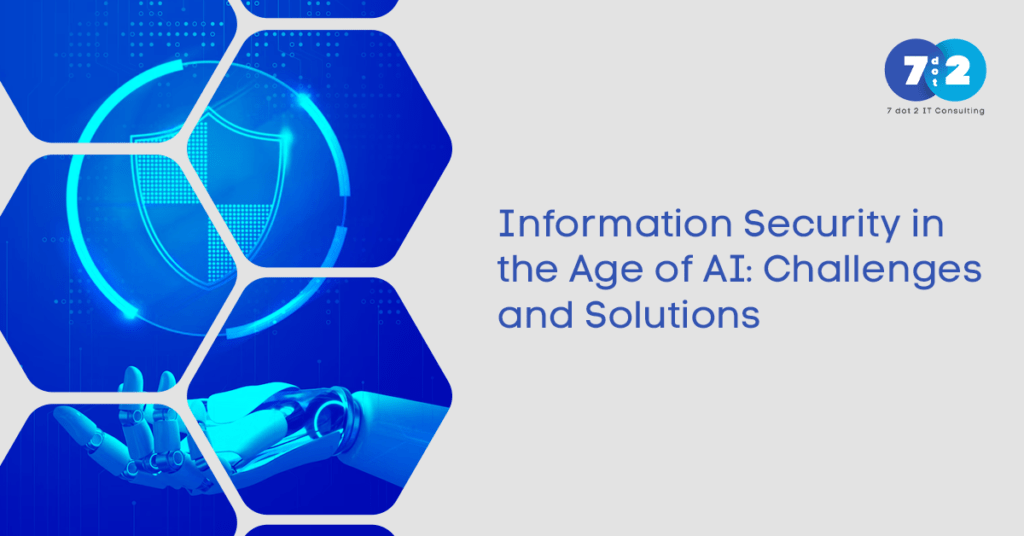Information Security in the Age of AI: Challenges and Solutions
Posted on : 16 November 2024 at 10:31 am, by Puneet Aggarwal, Founder 7 dot 2 IT Consulting

We live in a world increasingly shaped by the advent of artificial intelligence (AI). From predictive healthcare and autonomous vehicles to smart assistants and personalized marketing, AI is transforming industries at a breathtaking pace. But as machines grow smarter, so do the threats. Information security, already a pressing concern in the digital age has become more complex, dynamic, and high stakes with the widespread adoption of AI technologies.
In this blog, we explore how AI is reshaping the information security landscape, what new challenges it brings to the table, and the innovative solutions that can help protect data, infrastructure, and individual privacy in this evolving environment.
Why Information Security Matters?
With data now recognized as the new currency, information security is has become a business imperative and a societal necessity. AI systems thrive on data. They collect, analyse, and learn from vast amounts of it to deliver intelligent outputs. But this dependency on data also makes them highly vulnerable targets.
A single security breach can lead to devastating consequences: from identity theft and financial loss to large-scale disruptions in healthcare, energy, or even national security.
Challenges of Information Security
Here are some of the key risks and possible challenges information security might face.
1. AI-Powered Cyber Threats
Ironically, the same AI that protects us can also be used against us. Cybercriminals are leveraging AI to launch more sophisticated attacks. Examples include:
a) Deepfakes used for impersonation and disinformation
b) AI-generated phishing emails that mimic human language with uncanny accuracy
c) Automated malware that can adapt in real-time to evade traditional detection systems
2. Vulnerability in AI Systems Themselves
AI models, especially large language models are prone to adversarial attacks. These are inputs specifically designed to fool the AI into making wrong decisions. For instance, a slightly altered image might trick an AI-powered surveillance system into misidentifying a person.
Additionally, AI systems are susceptible to data poisoning where attackers feed corrupted data into the system, affecting its outputs.
3. Data Privacy Concerns
AI thrives on big data, which often includes sensitive personal information. This creates significant privacy concerns. Questions around consent, transparency, and control over personal data have become central to the information security debate.
4. Regulatory and Ethical Gaps
Legislation often struggles to keep pace with technological innovation. The rapid rise of AI has exposed regulatory gaps, particularly around accountability. Who is responsible when an AI system fails? How do we audit algorithmic decisions? These questions complicate the security landscape.
Solutions and Strategies
While the challenges are significant, the future isn’t bleak. With the right blend of technology, policy, and human vigilance, we can secure our digital environments without stifling innovation. Here’s what we think can be the potential solutions.
1. AI for Cyber Defense
Just as AI empowers attackers, it can also fortify defenders. Cybersecurity systems powered by AI can detect anomalies in network traffic, predict vulnerabilities before they’re exploited, and respond in real time to neutralize threats.
These systems can continuously learn from past incidents, making them more robust over time.
2. Robust Encryption and Access Controls
With AI systems handling sensitive data, encryption must be non-negotiable. Organizations should also implement zero-trust architecture where no user or device is trusted by default, even if inside the network.
Multi-factor authentication, biometric logins, and role-based access can further enhance security.
3. Ethical AI Frameworks and Regulation
Governments and global organizations must work together to create guidelines for responsible AI use, mandate algorithmic transparency, and enforce data protection laws like GDPR and emerging AI Acts.
Regulation must be proactive rather than reactive.
4. Secure AI Development Lifecycle
Just as software goes through secure coding practices, AI should follow a secure model development lifecycle. This includes thorough testing against adversarial inputs, data validation to prevent poisoning, and periodic audits and updates of the AI model.
5. Cybersecurity Awareness and Training
Technology alone cannot solve security problems. Employees remain one of the weakest links in the security chain. Ongoing training, simulations, and awareness campaigns can reduce human error and foster a culture of security.
Conclusion
AI is here to stay, and its role in shaping the digital future will only increase with time. But this progress must not come at the cost of security or trust. As organizations, governments, and individuals, we must approach AI not just with enthusiasm, but with caution and responsibility.
At 7dot2, we empower businesses to navigate the evolving digital landscape with confidence.
